2016 FORD F150 tow
[x] Cancel search: towPage 5 of 505

Power Running Boards
Using Power Running Boards....................76
Steering Wheel
Adjusting the Steering Wheel....................78
Audio Control...................................................79
Voice Control...................................................80
Cruise Control
.................................................80
Information Display Control......................80
Pedals
Adjusting the Pedals......................................81
Wipers and Washers
Windshield Wipers
.........................................82
Autowipers.......................................................82
Windshield Washers
.....................................83
Lighting
Lighting Control
..............................................84
Autolamps........................................................84
Instrument Lighting Dimmer
.....................85
Daytime Running Lamps
............................86
Automatic High Beam Control.................86
Front Fog Lamps............................................88
Direction Indicators
.......................................88
Spot Lamps.....................................................88
Interior Lamps.................................................89
Ambient Lighting
.............................................91
Windows and Mirrors
Power Windows
..............................................92
Exterior Mirrors
................................................93
Interior Mirror
....................................................97
Sliding Windows
.............................................97
Sun Visors
.........................................................97
Moonroof..........................................................98 Instrument Cluster
Gauges.............................................................100
Warning Lamps and Indicators...............103
Audible Warnings and Indicators............107
Information Displays
General Information....................................108
Information Messages................................124
Climate Control
Manual Climate Control.............................139
Automatic Climate Control........................141
Hints on Controlling the Interior
Climate.........................................................142
Heated Windows and Mirrors..................145
Cabin Air Filter...............................................145
Remote Start.................................................146
Seats
Sitting in the Correct Position..................147
Head Restraints
.............................................147
Manual Seats.................................................149
Power Seats
...................................................150
Memory Function
..........................................152
Rear Seats
.......................................................154
Heated Seats.................................................154
Climate Controlled Seats..........................155
Front Seat Armrest.......................................157
Rear Seat Armrest
........................................157
Universal Garage Door Opener
Universal Garage Door Opener...............158
Auxiliary Power Points
Auxiliary Power Points................................162
Storage Compartments
Center Console..............................................164
2
F-150 (TFC) Canada/United States of America, enUSA, Edition date: 08/2015, First Printing Table of Contents
Page 6 of 505

Overhead Console.......................................165
Starting and Stopping the Engine
General Information
....................................166
Ignition Switch
...............................................166
Keyless Starting
............................................166
Starting a Gasoline Engine........................167
Engine Block Heater
....................................170
Unique Driving Character- istics
Auto-Start-Stop............................................172
Fuel and Refueling
Safety Precautions
.......................................174
Fuel Quality
.....................................................175
Fuel Quality
.....................................................175
Running Out of Fuel.....................................176
Refueling...........................................................177
Fuel Consumption........................................178
Emission Control System..........................179
Transmission
Automatic Transmission
............................182
Four-Wheel Drive
Using Four-Wheel Drive
............................188
Rear Axle
Electronic Locking Differential
................196
Brakes
General Information
....................................198
Hints on Driving With Anti-Lock Brakes...........................................................198
Parking Brake.................................................198
Electric Parking Brake.................................199
Hill Start Assist..............................................201 Traction Control
Principle of Operation
................................203
Using Traction Control...............................203
Stability Control
Principle of Operation...............................204
Using Stability Control..............................205
Terrain Response
Principle of Operation
................................207
Using Hill Descent Control.......................207
Parking Aids
Parking Aid.....................................................209
Active Park Assist.........................................210
Rear View Camera........................................214
360 Degree Camera.....................................217
Cruise Control
Principle of Operation
................................220
Using Cruise Control...................................220
Using Adaptive Cruise Control.................221
Driving Aids
Driver Alert
......................................................228
Lane Keeping System................................228
Blind Spot Information System
..............232
Cross Traffic Alert........................................234
Steering............................................................237
Collision Warning System........................238
Load Carrying
Load Retaining Fixtures..............................241
Load Limit
.......................................................242
Bed Access....................................................248
Bed Ramps
....................................................249
Towing
Towing a Trailer
.............................................252
3
F-150 (TFC) Canada/United States of America, enUSA, Edition date: 08/2015, First Printing Table of Contents
Page 7 of 505

Pro Trailer Backup Assist™......................253
Trailer Sway Control...................................262
Recommended Towing Weights...........262
Essential Towing Checks
..........................269
Towing Points
................................................276
Transporting the Vehicle............................277
Towing the Vehicle on Four Wheels......278
Driving Hints
Breaking-In......................................................281
Economical Driving
......................................281
Driving Through Water
...............................282
Floor Mats
.......................................................282
Snowplowing................................................283
Roadside Emergencies
Roadside Assistance..................................286
Hazard Warning Flashers
..........................287
Fuel Shutoff
...................................................287
Jump Starting the Vehicle........................288
Post-Crash Alert System
..........................290
Customer Assistance
Getting the Services You Need................291
In California (U.S. Only)
.............................292
The Better Business Bureau (BBB) Auto Line Program (U.S. Only)
.....................293
Utilizing the Mediation/Arbitration Program (Canada Only).......................294
Getting Assistance Outside the U.S. and Canada........................................................294
Ordering Additional Owner's Literature....................................................295
Reporting Safety Defects (U.S. Only)............................................................296
Reporting Safety Defects (Canada Only)............................................................296
Fuses
Fuse Specification Chart..........................298
Changing a Fuse
..........................................306 Maintenance
General Information
...................................307
Opening and Closing the Hood..............307
Under Hood Overview - 2.7L EcoBoost™...............................................308
Under Hood Overview - 3.5L Ecoboost™...............................................309
Under Hood Overview - 3.5L....................310
Under Hood Overview - 5.0L.....................311
Engine Oil Dipstick........................................312
Engine Oil Check...........................................312
Engine Coolant Check.................................313
Automatic Transmission Fluid Check.............................................................317
Transfer Case Fluid Check.........................317
Brake Fluid Check.........................................318
Power Steering Fluid Check.....................318
Washer Fluid Check
.....................................318
Fuel Filter
.........................................................318
Changing the 12V Battery..........................318
Checking the Wiper Blades
.....................320
Changing the Wiper Blades
.....................320
Adjusting the Headlamps..........................321
Changing a Bulb...........................................322
Bulb Specification Chart...........................327
Changing the Engine Air Filter................329
Vehicle Care
General Information
...................................330
Cleaning Products
.......................................330
Cleaning the Exterior..................................330
Waxing..............................................................331
Cleaning the Engine
....................................332
Cleaning the Windows and Wiper Blades..........................................................332
Cleaning the Interior...................................333
Cleaning the Instrument Panel and Instrument Cluster Lens........................333
Cleaning Leather Seats.............................334
Repairing Minor Paint Damage...............335
4
F-150 (TFC) Canada/United States of America, enUSA, Edition date: 08/2015, First Printing Table of Contents
Page 17 of 505
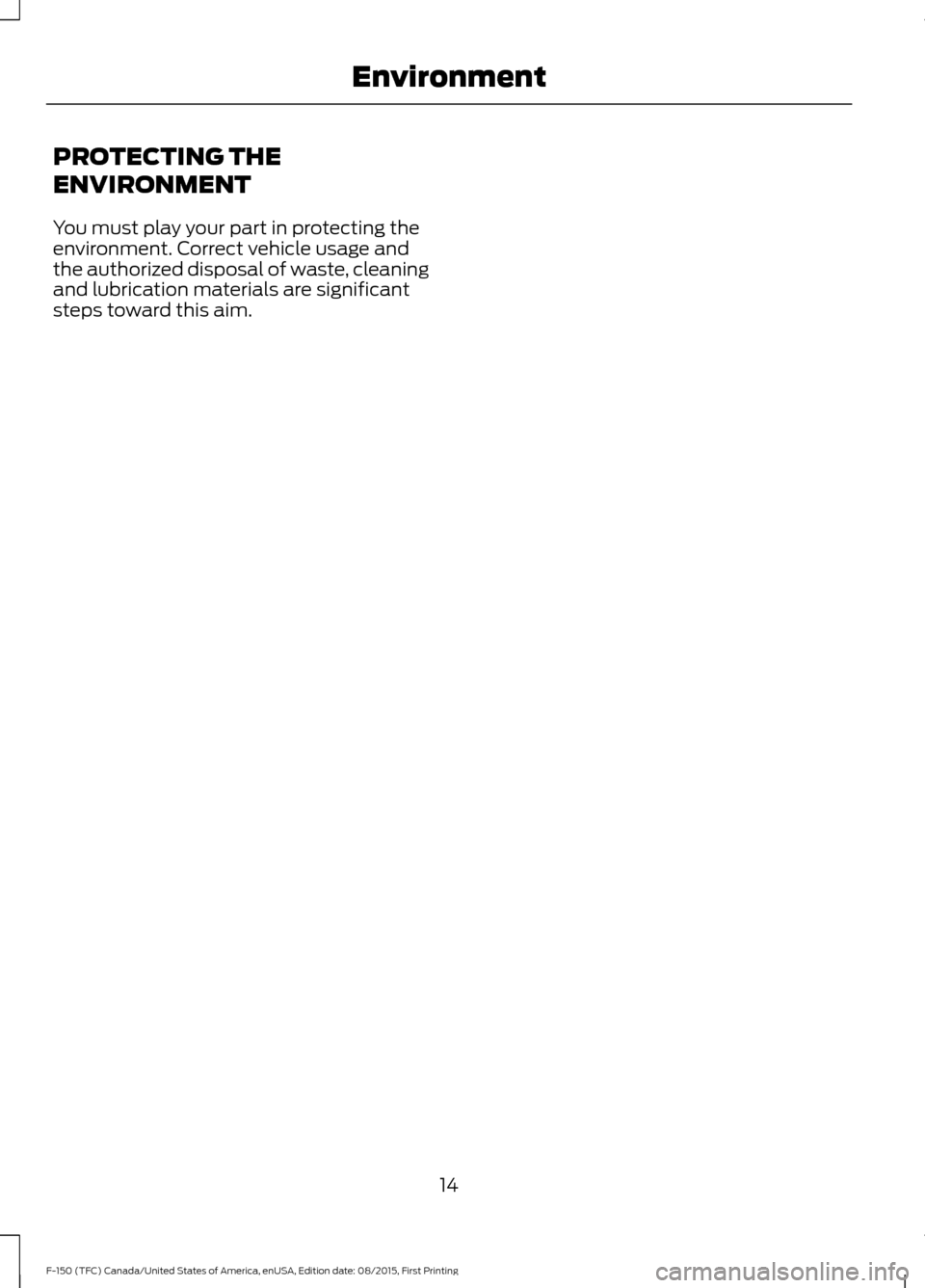
PROTECTING THE
ENVIRONMENT
You must play your part in protecting the
environment. Correct vehicle usage and
the authorized disposal of waste, cleaning
and lubrication materials are significant
steps toward this aim.
14
F-150 (TFC) Canada/United States of America, enUSA, Edition date: 08/2015, First Printing Environment
Page 22 of 505
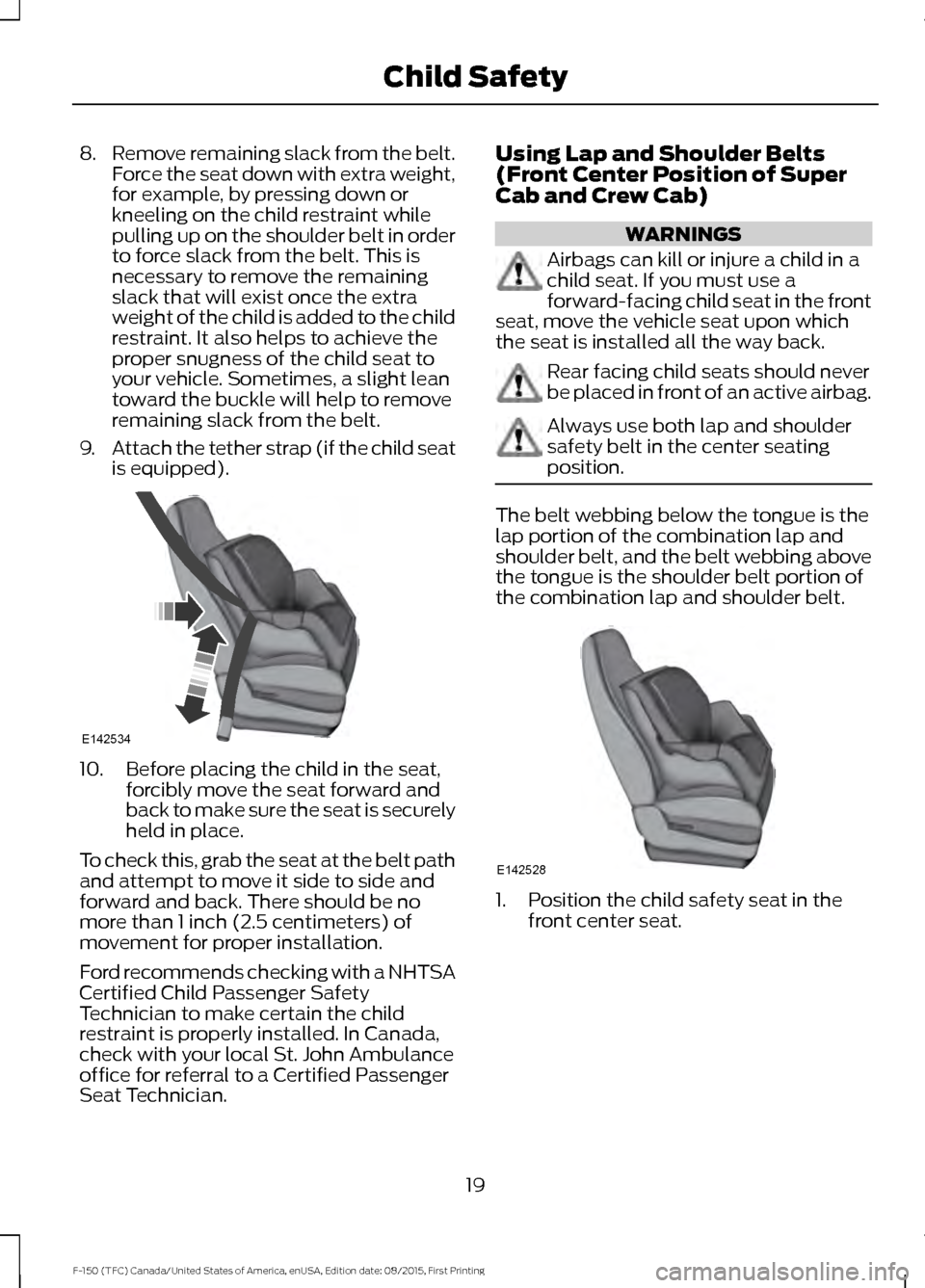
8.
Remove remaining slack from the belt.
Force the seat down with extra weight,
for example, by pressing down or
kneeling on the child restraint while
pulling up on the shoulder belt in order
to force slack from the belt. This is
necessary to remove the remaining
slack that will exist once the extra
weight of the child is added to the child
restraint. It also helps to achieve the
proper snugness of the child seat to
your vehicle. Sometimes, a slight lean
toward the buckle will help to remove
remaining slack from the belt.
9. Attach the tether strap (if the child seat
is equipped). 10. Before placing the child in the seat,
forcibly move the seat forward and
back to make sure the seat is securely
held in place.
To check this, grab the seat at the belt path
and attempt to move it side to side and
forward and back. There should be no
more than 1 inch (2.5 centimeters) of
movement for proper installation.
Ford recommends checking with a NHTSA
Certified Child Passenger Safety
Technician to make certain the child
restraint is properly installed. In Canada,
check with your local St. John Ambulance
office for referral to a Certified Passenger
Seat Technician. Using Lap and Shoulder Belts
(Front Center Position of Super
Cab and Crew Cab) WARNINGS
Airbags can kill or injure a child in a
child seat. If you must use a
forward-facing child seat in the front
seat, move the vehicle seat upon which
the seat is installed all the way back. Rear facing child seats should never
be placed in front of an active airbag.
Always use both lap and shoulder
safety belt in the center seating
position.
The belt webbing below the tongue is the
lap portion of the combination lap and
shoulder belt, and the belt webbing above
the tongue is the shoulder belt portion of
the combination lap and shoulder belt.
1. Position the child safety seat in the
front center seat.
19
F-150 (TFC) Canada/United States of America, enUSA, Edition date: 08/2015, First Printing Child SafetyE142534 E142528
Page 26 of 505
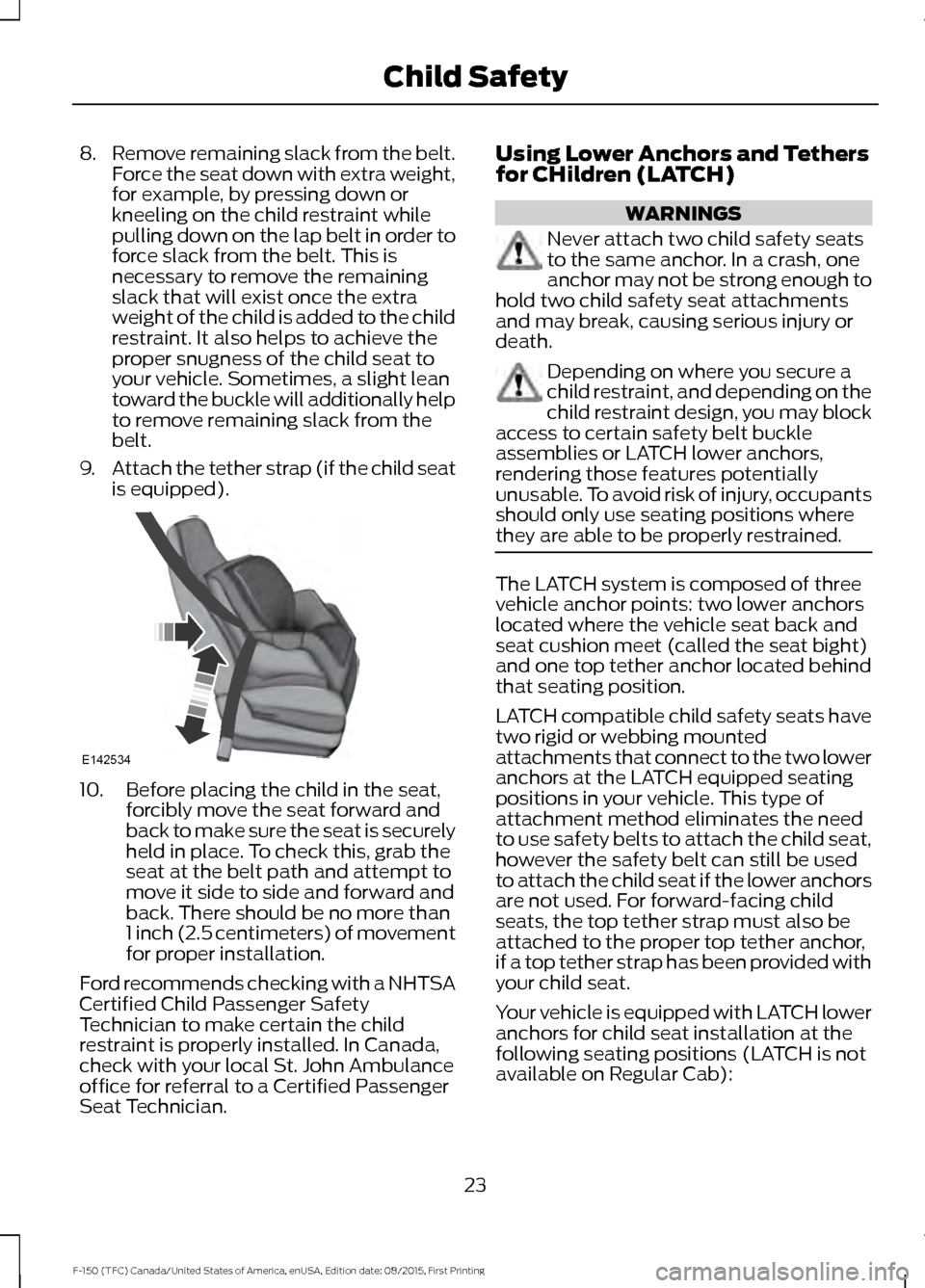
8.
Remove remaining slack from the belt.
Force the seat down with extra weight,
for example, by pressing down or
kneeling on the child restraint while
pulling down on the lap belt in order to
force slack from the belt. This is
necessary to remove the remaining
slack that will exist once the extra
weight of the child is added to the child
restraint. It also helps to achieve the
proper snugness of the child seat to
your vehicle. Sometimes, a slight lean
toward the buckle will additionally help
to remove remaining slack from the
belt.
9. Attach the tether strap (if the child seat
is equipped). 10. Before placing the child in the seat,
forcibly move the seat forward and
back to make sure the seat is securely
held in place. To check this, grab the
seat at the belt path and attempt to
move it side to side and forward and
back. There should be no more than
1 inch (2.5 centimeters) of movement
for proper installation.
Ford recommends checking with a NHTSA
Certified Child Passenger Safety
Technician to make certain the child
restraint is properly installed. In Canada,
check with your local St. John Ambulance
office for referral to a Certified Passenger
Seat Technician. Using Lower Anchors and Tethers
for CHildren (LATCH) WARNINGS
Never attach two child safety seats
to the same anchor. In a crash, one
anchor may not be strong enough to
hold two child safety seat attachments
and may break, causing serious injury or
death. Depending on where you secure a
child restraint, and depending on the
child restraint design, you may block
access to certain safety belt buckle
assemblies or LATCH lower anchors,
rendering those features potentially
unusable. To avoid risk of injury, occupants
should only use seating positions where
they are able to be properly restrained. The LATCH system is composed of three
vehicle anchor points: two lower anchors
located where the vehicle seat back and
seat cushion meet (called the seat bight)
and one top tether anchor located behind
that seating position.
LATCH compatible child safety seats have
two rigid or webbing mounted
attachments that connect to the two lower
anchors at the LATCH equipped seating
positions in your vehicle. This type of
attachment method eliminates the need
to use safety belts to attach the child seat,
however the safety belt can still be used
to attach the child seat if the lower anchors
are not used. For forward-facing child
seats, the top tether strap must also be
attached to the proper top tether anchor,
if a top tether strap has been provided with
your child seat.
Your vehicle is equipped with LATCH lower
anchors for child seat installation at the
following seating positions (LATCH is not
available on Regular Cab):
23
F-150 (TFC) Canada/United States of America, enUSA, Edition date: 08/2015, First Printing Child SafetyE142534
Page 33 of 505
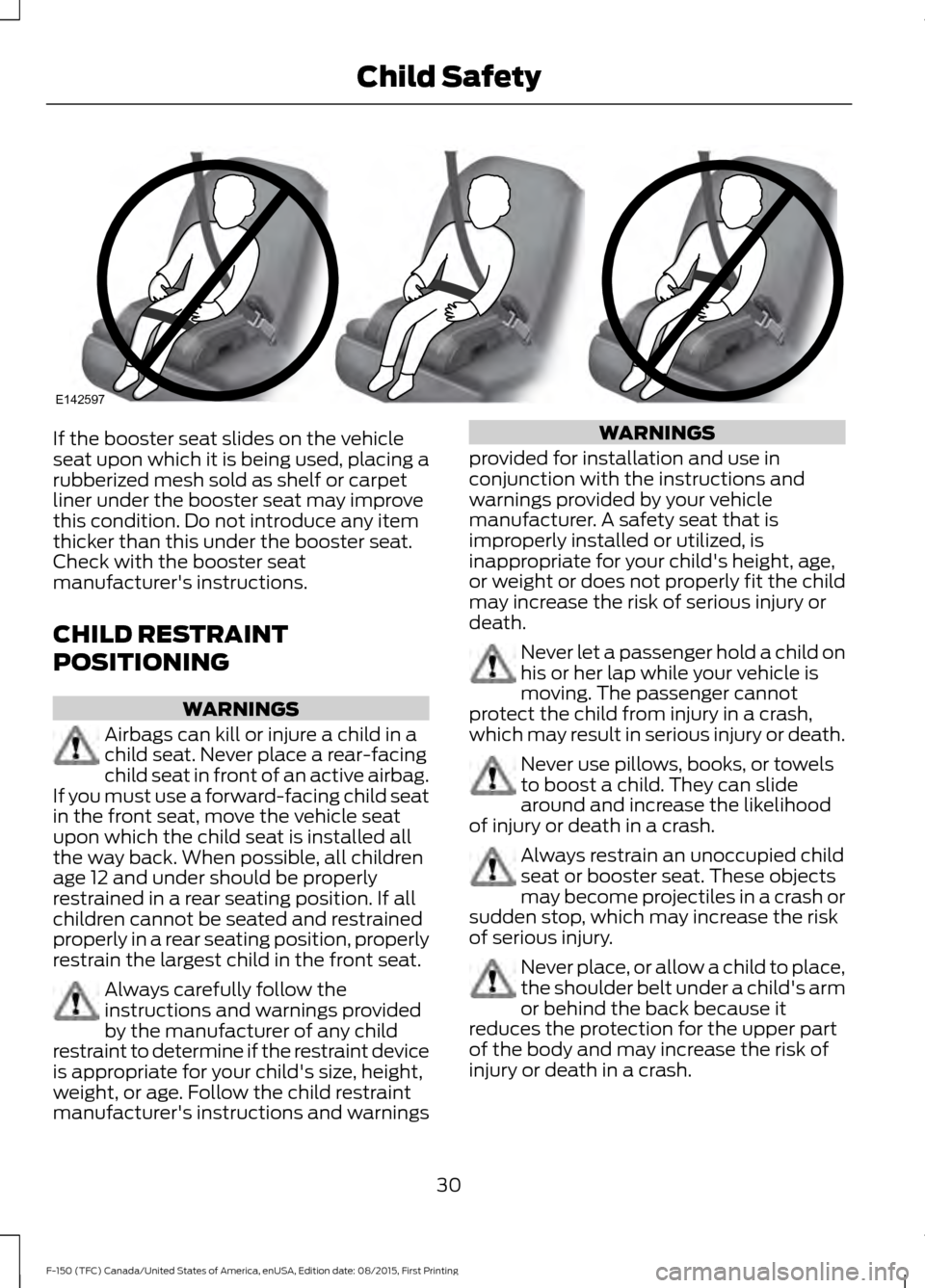
If the booster seat slides on the vehicle
seat upon which it is being used, placing a
rubberized mesh sold as shelf or carpet
liner under the booster seat may improve
this condition. Do not introduce any item
thicker than this under the booster seat.
Check with the booster seat
manufacturer's instructions.
CHILD RESTRAINT
POSITIONING
WARNINGS
Airbags can kill or injure a child in a
child seat. Never place a rear-facing
child seat in front of an active airbag.
If you must use a forward-facing child seat
in the front seat, move the vehicle seat
upon which the child seat is installed all
the way back. When possible, all children
age 12 and under should be properly
restrained in a rear seating position. If all
children cannot be seated and restrained
properly in a rear seating position, properly
restrain the largest child in the front seat. Always carefully follow the
instructions and warnings provided
by the manufacturer of any child
restraint to determine if the restraint device
is appropriate for your child's size, height,
weight, or age. Follow the child restraint
manufacturer's instructions and warnings WARNINGS
provided for installation and use in
conjunction with the instructions and
warnings provided by your vehicle
manufacturer. A safety seat that is
improperly installed or utilized, is
inappropriate for your child's height, age,
or weight or does not properly fit the child
may increase the risk of serious injury or
death. Never let a passenger hold a child on
his or her lap while your vehicle is
moving. The passenger cannot
protect the child from injury in a crash,
which may result in serious injury or death. Never use pillows, books, or towels
to boost a child. They can slide
around and increase the likelihood
of injury or death in a crash. Always restrain an unoccupied child
seat or booster seat. These objects
may become projectiles in a crash or
sudden stop, which may increase the risk
of serious injury. Never place, or allow a child to place,
the shoulder belt under a child's arm
or behind the back because it
reduces the protection for the upper part
of the body and may increase the risk of
injury or death in a crash.
30
F-150 (TFC) Canada/United States of America, enUSA, Edition date: 08/2015, First Printing Child SafetyE142597
Page 37 of 505
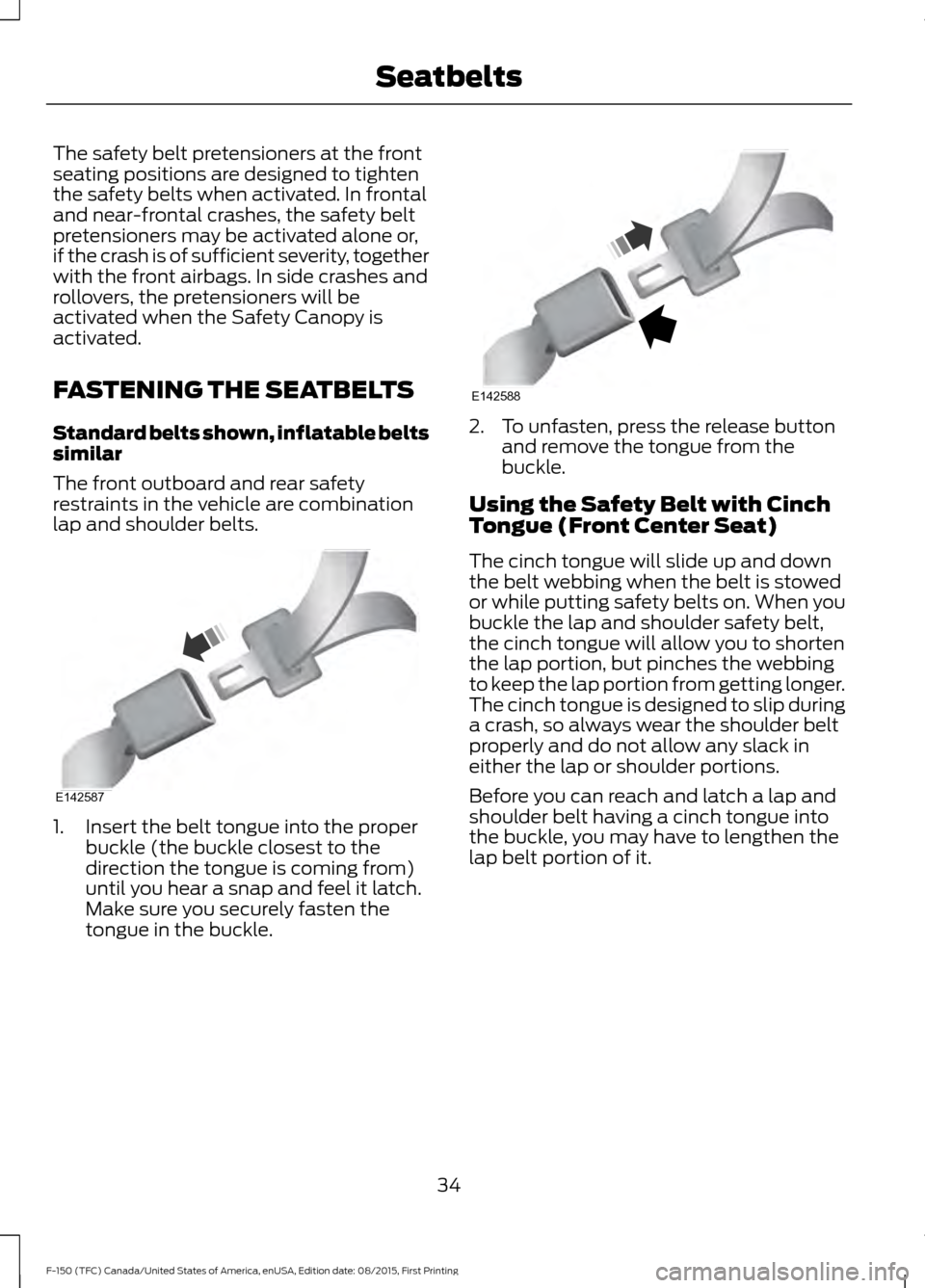
The safety belt pretensioners at the front
seating positions are designed to tighten
the safety belts when activated. In frontal
and near-frontal crashes, the safety belt
pretensioners may be activated alone or,
if the crash is of sufficient severity, together
with the front airbags. In side crashes and
rollovers, the pretensioners will be
activated when the Safety Canopy is
activated.
FASTENING THE SEATBELTS
Standard belts shown, inflatable belts
similar
The front outboard and rear safety
restraints in the vehicle are combination
lap and shoulder belts.
1. Insert the belt tongue into the proper
buckle (the buckle closest to the
direction the tongue is coming from)
until you hear a snap and feel it latch.
Make sure you securely fasten the
tongue in the buckle. 2. To unfasten, press the release button
and remove the tongue from the
buckle.
Using the Safety Belt with Cinch
Tongue (Front Center Seat)
The cinch tongue will slide up and down
the belt webbing when the belt is stowed
or while putting safety belts on. When you
buckle the lap and shoulder safety belt,
the cinch tongue will allow you to shorten
the lap portion, but pinches the webbing
to keep the lap portion from getting longer.
The cinch tongue is designed to slip during
a crash, so always wear the shoulder belt
properly and do not allow any slack in
either the lap or shoulder portions.
Before you can reach and latch a lap and
shoulder belt having a cinch tongue into
the buckle, you may have to lengthen the
lap belt portion of it.
34
F-150 (TFC) Canada/United States of America, enUSA, Edition date: 08/2015, First Printing SeatbeltsE142587 E142588